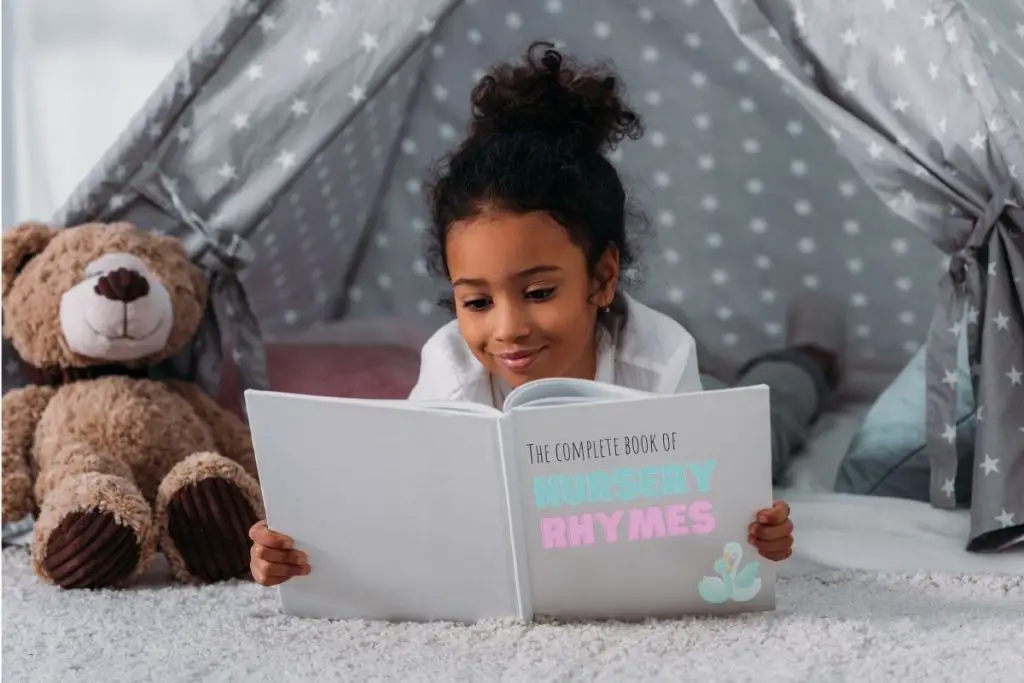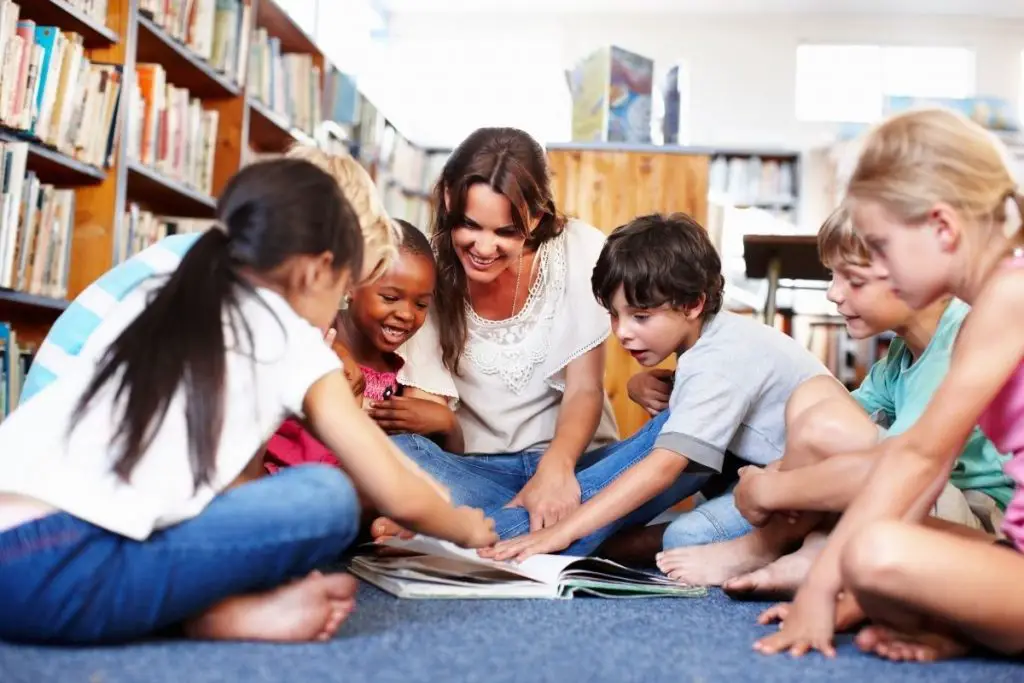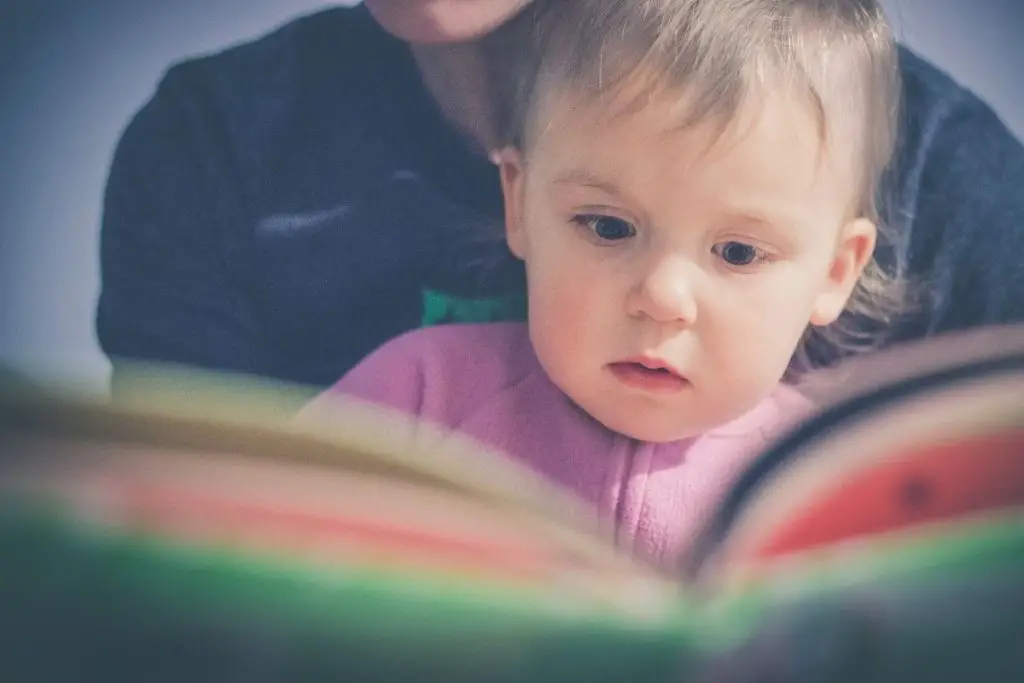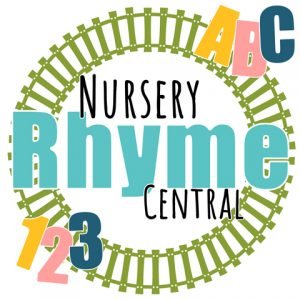Teaching children nursery rhymes can play an essential role in children’s cognitive, emotional, social, and language development. Nursery rhymes can even help children with their reading development – not in a formal way, but through fun daily activities.
Hearing, learning, and reciting nursery rhymes can help children develop into proficient readers. Nursery rhymes help reading development by introducing pre-literacy and early reading skills, such as phonics and alphabet recognition, and the desire to read in a fun and informal way.
Reading development, in particular, is stimulated by having fun with nursery rhymes. According to Fox (2001), “Experts in literacy and child development have discovered that if children know eight nursery rhymes by heart by the time they’re four years old, they’re usually among the best readers by the time they’re eight.”

Although children learn to read and write at school at around the age of six, their language development actually begins much earlier – from birth. By the time they are a few months old, children should be hearing and enjoying nursery rhymes, to benefit their language development.
There are many ways of introducing and teaching pre-literacy and early reading skills through nursery rhymes and without formal lessons which we will look at later. But first let’s look at how children develop into readers and what role nursery rhymes can play.
How children learn to read
Learning to read in English, an alphabetic language, is a complex process. Children learn to decipher or decode the letters printed on a page or screen into corresponding sounds that are combined to make up meaningful words, sentences, and, ultimately, stories.
Approaches to reading development
How children learn – or are taught – to read is a question parents and educators have wrestled with for centuries. Approaches to reading development are ever-changing, with different pedagogical or teaching approaches coming to the fore at other times. There are two main approaches to reading development: the whole language approach and phonics, and I will tell you which approach I have personally taken, as a trained teacher, with my four children before they attended school at age 5 with great results!
The whole language approach
From the 1980s to the 2000s, the whole language approach was popular in US education. This gradual approach maintains that children learn to read when surrounded by reading materials, stories, and the opportunity to write. Specifically, children slowly learn to read by sight rather than sound: word recognition, contextual guessing, and comprehension based on a frame of reference, rather than by sounding out parts of words.
This approach has fallen out of favor in many schools as it can hamper children with special educational needs, and generally results in poor spelling.
Phonics
For the past 20 years or so, phonics or a phonetic approach to reading development has been very popular. This approach uses the phonemes or sounds letters make to teach children to read by sounding out the letters of words, blending them, and coming up with words.
However, extreme versions of phonics approaches lead to word comprehension being ignored in favor of decoding sounds and practicing drills to the story’s detriment.
A balanced approach to reading development
Today most educators would agree that a balanced approach is needed when children are learning to read – decoding sounds needs to be supplemented by vocabulary development and an understanding of language and grammar for fluent reading. Hence, most early literacy learning focuses on learning phonics and phonic patterns, with word recognition, vocabulary development, and story comprehension becoming important as children begin reading alone.
The approach I have taken with my children at home – before starting school.
Having studied education at university and having taught years 1-6 in schools in Australia I am well aware of the largely phonics approach to reading that occurs in the classroom. I have always felt that it is therefore my job as my children’s parent and their first teacher to immerse them in language and books, but not through flashcards, reading programs or lessons but through everyday experience.
Every night we read together before bed (well my older children 11 and 9 at the time of writing this read copious amounts of chapter books at night throughout the week), we visit the library at least once a month if not more especially if there is storytime on, my husband and I regularly read in front of our children, we decode road signs together, look at all the words on cereal boxes at breakfast etc… and of course, I sing and share nursery rhymes with them. We especially love the ones that have accompanying hand movements or books that have the characters from nursery rhymes or the nursery rhymes themselves. Then when each of my children has moved onto formal learning it doesn’t take them long, around the age of 6 or 7 until all of the experiences I have given them and the learning they are doing at school clicks and they slowly develop into independent readers!
Stages of reading development
Most educators agree that there are developmental stages in the journey towards learning to read independently. Some theories lay out a ground work of five stages and others six, but a common thread is that the first stage is generally when a child is between 6 months and 6 years. Nursery rhymes play their most important role in this first stage of learning to read. A quick review of the stages of reading can be seen as follows:
- Pre-reading: From birth to six years, children become aware of reading and learn the skills needed as a foundation for reading development.
- Initial reading and decoding: From six to eight years, children learn (and are explicitly taught) how to decode the sounds and letters that constitute words.
- Confirmation and fluency: Around eight to nine years, children can read primary texts using a combination of decoding, recognizing ‘sight’ words, and using context to fill in comprehension’ clues’.
- Reading for ‘learning the new’: Between nine and thirteen, children develop the ability to read to gain knowledge and information and experience new feelings and attitudes via reading.
- Multiple viewpoints: From the age of 14, most teenagers read fluently across a broad range of subjects, taking numerous points of view into account.
- Construction and reconstruction: Adults from age 18 and upwards can integrate the new knowledge and experience gained via reading with prior knowledge; many adults read quickly, efficiently, and for various purposes, including for pleasure.
How nursery rhymes help kids learn to read

Most approaches to reading development focus on the very beginning stage of reading, termed pre-reading. Pre-reading skills are skills children need to master as the foundation of initial reading, decoding, and later fluent, confident reading. There are three sets of pre-reading skills that the emerging or pre-reader needs to master:
- Phonological skills, relating to the awareness of the sound of language
- Print-related skills, relating to the visual aspects of reading.
- Vocabulary and comprehension skills.
Pre-reading skills are developed primarily by reading aloud to children, answering their questions about what is being read, and appreciating their interest in books, rhymes, and stories. Reading and enjoying nursery rhymes with children forms a central part of this process. Let’s look at how nursery rhymes help children during the pre-reading stage.
How nursery rhymes help develop phonological pre-reading skills
Listening and speaking skills
Children’s first step towards reading is learning how to listen and understand. In other words, listening comprehension precedes reading comprehension. Listening is a natural part of speech and language development, as babies hear and repeat the sounds made to and around them. Speaking to babies and ‘having conversations’ where you respond to their sounds as if they have meaning is essential in developing these skills.
Playing, singing, and reading nursery rhymes aloud helps develop children’s listening skills in terms of meaning and how voices sound when reading: the so-called storytelling voice or sing-song intonation used when chanting rhymes. Children learn articulation, enunciation, pronunciation, intonation, modulation, and pitch when listening to someone reading aloud. This informal listening becomes a practical skill when children learn to recite nursery rhymes and even later when they read aloud themselves.
Another important skill children will become familiar with by listening to as well as saying and singing nursery rhymes, is chunking or breaking words into syllables. When we sing nursery rhymes we generally break the words up into their syllables to create the rhythm of the rhyme for example Hump – ty Dump – ty sat on the wall. We break the words Humpty and Dumpty into two chunks which is an important skill in later stages of reading to help decode words and blend and string together the sounds of all the letters more easily. Syllabification is a skill even advanced readers rely on to decode unfamiliar or extremely long words.
HOW YOU CAN USE NURSERY RHYMES TO DEVELOP LISTENING SKILLS AT HOME
- Sing lullabies, such as ‘Rock-a-bye baby’ and ‘Bye baby bunting’.
- Play tickling games, especially at nappy changing times, for instance, ‘This little piggy’, ‘Round and round the garden’, ‘Incy wincy spider’.
- Play interactive games, such as ‘Ride a cock horse’, with a child on your knee, ‘Pat-a-cake’ or ‘Seesaw, Margery Daw’.
- Play and sing appropriate nursery rhymes in the car, such as ‘The wheels on the bus’.
- Sing complimentary nursery rhymes in the bath, such as ‘Rub-a-dub-dub’.
- Clap or beat out rhymes and rhythms, or use simple musical instruments, such as drums or shakers, to songs like ‘The Grand Old Duke of York’.
- As well as clapping out the beat of the rhyme, you can also begin clapping out the syllables of the words in the rhyme, which in many cases is the rhythm. Hump – ty Dump – ty (clap–clap, clap–clap). Learning how to break up syllables is helpful when decoding words in the next stages of reading.
Phonological and phonemic awareness
Phonological awareness is a special kind of listening, referring to the ability to hear, distinguish between and manipulate the sound structures within language. Children learn to speak without needing to differentiate the individual sounds (phonemes) within words of a language. However, the ability to read rests on decoding the unique sounds or phonemes as represented by letters. Phonemic awareness is an aspect of phonological awareness and is the ability to listen for and differentiate between different sounds in words. Developing phonemic awareness is an essential pre-reading skill. For example, phonemic awareness of the word ‘dog’ would highlight that the word has a single syllable but consists of three different sounds: /d/, /o/ and /g/.
Nursery rhymes are useful for developing phonological and specifically phonemic awareness in young children and pre-readers because their repetitive rhythms and rhymes help children develop an ear for sounds. Using nursery rhymes, children learn to recognize, detect but also explicitly and purposefully analyze, manipulate and produce words that sound the same and those that sound different, specifically:
- repeated groups of sounds, both vowels (rhyme) and consonants (alliteration)
- stressed and unstressed sounds and syllables
- syllables composed of more than one sound.
HOW YOU CAN USE NURSERY RHYMES TO DEVELOP PHONEMIC AWARENESS AT HOME.
When reading nursery rhymes with children, you can introduce phonemic awareness informally through activities like the following.
Recognize rhyming words and alliteration
Hey, diddle, diddle, the cat and the fiddle,
The cow jumped over the moon.
The little dog laughed to see such fun
And the dish ran away with the spoon
- Read nursery rhymes aloud to children and remark to yourself – wow those words moon and spoon sound similar! You can also point to the words as you read to develop the relationship between the words and what you are saying as well as make your child aware of the direction we read text on a page.
- With young children 2-3 I would begin by making them aware of the rhyming words. Once they are familiar with the rhyme, begin to omit the rhyming words yourself so your child can say them or guess the words themselves.
- Play games where you make up words that rhyme even if they don’t make sense and have fun with it.
- As children get older 3-4yrs you might like to Introduce children to finding the rhyming words themselves: diddle/fiddle – wow they sound so similar! I wonder if we can hear any other words that sound the same? moon/spoon.
- Around 4-6 you can start to create lists (these do not have to be written down) of some rhyming words to add to the nursery rhyme, for instance, moon, spoon, soon, noon. You can also add nonsense words to laugh about, such as foon, poon, hoon.
- You could also try to introduce children this age to alliteration: D-d-d-d-d-diddle and D-d-d-d-d-dog. I can hear the same sound at the start! Can you hear the d sound? I wonder if there are any other words that sound the same at the beginning? diddle, diddle, dog, dish, or cow and cat.
Identify rhyme and alliteration oddities
Twinkle, twinkle, little star,
How I wonder what you are.
Up above the world so high,
Like a diamond in the sky.
Twinkle, twinkle, little star,
How I wonder what you are.
- Encourage children to identify words that do not rhyme or alliterate: Do the words’ twinkle’, ‘high’ and ‘star’ sound the same? Do they have the same sounds in the middle or end of the word? Do they have the same sounds at the beginning of the word?
- Once children are familiar with a nursery rhyme, you can ask them to fill in the missing rhyme at the end of a sentence: ‘Twinkle, twinkle little …?’
- You can also replace the word star with an oddity for them to point out: ‘Twinkle, twinkle, little dog’.
How nursery rhymes help develop print-related pre-reading skills

Reading nursery rhymes aloud with a child also helps them develop the visual pre-reading skills they need to combine with phonological skills to begin reading’s decoding process. Awareness of books as objects for reading is also an essential pre-reading skill that forms the basis of learning to read.
Book and print orientation
The first step is simply teaching a child how to hold a book with two hands and turn the pages. In English, we read from left to right, moving from top to bottom. The book progresses from left to right. Children who are read to, learn by observation and later by holding books themselves. An important part of the pre-reading stage is for children to handle books themselves, turning the pages and ‘pseudo-reading’, where children retell or create the story themselves or just look at the pictures in order. The first series of questions in most reading tests for children entering school or year 1 pertain to if they know how to use or (pseudo) read a book correctly. The teacher will place a book upside down and backward on a table and ask the child to pick the book up and look at it and then show them the front or front cover of the book. They may ask where the title of the book is, which way we open the book, which way we turn the pages, where the words are etc… These basic skills might seem simple to us but are the foundations of reading. A child’s knowledge of how a book works gives their teacher a wealth of knowledge and starting point for teaching that child in their classroom the skills they need to read.
Alphabetic awareness
Once children have developed some phonemic awareness, they will need to expand this knowledge to decode and recognize the symbols that represent each of the letters of the alphabet as well as their corresponding names and in most cases multiple sounds. Combining these skills allows a child to move from pre-reading to the decoding stage of reading. Children learn that words consist of letters and that each specific letter is different and produces a different sound. Children then learn to recognize whole words as well as the blends, diagraphs, and other letter combinations that produce the sounds that create words.
How you can use nursery rhymes to develop alphabetic awareness
Humpty Dumpty sat on a wall,
Humpty Dumpty had a great fall.
All the king’s horses and all the king’s men
Couldn’t put Humpty together again.
- Introduce children to different letters of the alphabet. Point out and name ‘h’ and ‘d’ in ‘Humpty Dumpty’. It is easiest to point out the first letters at this stage. Also link letters to other words, for example, ‘Your name, Helen, also starts with h.’
- Play games with the text of the book – get your child to find another H on the page. Just be aware that at this stage your child will not have a good grasp that an upper case H and a lower case h are the same so make sure you just look for one or the other each time.
- This then leads onto finding words in the text that are the same that begin with lower case and upper case letters for example the letter a in All and again – but this is a hard skill to learn and understand so there is no need to push this skill fully at a pre-reading stage, the aim is to create an awareness of the terminology and familiarity with the words upper and lower case as well as the fact that letters can be represented in different ways.
- You can also introduce children to whole words. Use your finger to point out that a word says ‘Humpty’, or use your finger to follow the text as you read each word.
How nursery rhymes help to develop vocabulary and comprehension skills
Vocabulary refers to the words available for use in a language whereas comprehension refers to the ability to understand what those words mean in context. As children develop their ability to decode, identify letters, and work sounds out, they need to also understand what the words they are reading mean in isolation as well as in relation to each other or how they combine as meaningful sentences. Memorization, or the ability to remember what is learned, is a cognitive skill and is the basis of building a large and vast vocabulary.
Vocabulary development
Singing and saying nursery rhymes as well as reading aloud to children introduces them to more new words than they might naturally come across in conversation with you on a daily basis. It encourages word recognition and comprehension by exposing them to new words as well as known words in different and varying sentences and sentence patterns. By age 18 months, children can add to their vocabulary at a rate of a word an hour. By age two, children have a vocabulary of around 1000 words and 2000 words. The more words a child is exposed to the more they learn and know.
Comprehension development
Nursery rhymes help to consolidate children’s understanding of what various words mean especially when we add in hand or body actions to a rhyme or read books with pictures that describe the things or actions in them. For example when singing ‘The grand old Duke of York’.
| Nursery Rhyme Words | Actions |
|---|---|
| The grand old Duke of York, He had ten thousand men; | Marching to the beat of the rhyme |
| He marched them up to the top of the hill, | Start marching on your tippy-toes |
| And he marched them down again. | Begin marching with bent knees |
| When they were up, they were up, | March on your tippy-toes |
| And when they were down, they were down, | March low with bent knees |
| And when they were only halfway up, | March at your regular height |
| They were neither up nor down. | Keep marching but on the word ‘up’ push up onto your tippy toes and on the word ‘down’ bend your knees low. |
To begin with, there are the words Grand, Duke, and York. Words we probably don’t use on an everyday basis – What do they all mean? A picture of the Duke depicted in a book may give your child an understanding that the main character was a leader of an army. Then there are the directional words ‘up’ and ‘top’, ‘halfway’ and ‘down’ all of which we can follow with our bodies as described in the table above. These simple activities help children develop their understandings of what words mean.
Understanding literary genre
Literary genres are different kinds of writing that children will encounter as they learn to read, for example, fiction, fantasy, non-fiction or poetry. At the pre-reading stage, children are simply becoming aware that books and literature exist.
Nursery rhymes are miniature stories that introduce children to the structure of stories: the sequence of a beginning, middle, and end. Understanding how stories work is an essential pre-reading skill.
Nursery rhymes are also a type of poetry and introduce children on a fundamental level to literary devices such as rhyme, rhythm, and alliteration. Nursery rhymes also stimulate children’s creative development as they use their imagination and sense of humor once they comprehend the stories. The next step is emotional development, as children use nursery rhymes to express and reflect their feelings. You can read more about how nursery rhymes are a form of poetry in our article Are Nursery Rhymes Really Poetry?
How to use nursery rhymes to develop vocabulary and comprehension skills at home.
Vocabulary development
- Point out parts of bodies in songs and tickling games, such as ‘Head, shoulders, knees, and toes’.
- ‘This is the way – we brush our hair/put on our shoes etc…’ is an excellent general song to accompany various daily activities and highlight the associated vocabulary.
Memorizing vocabulary
- Learning nursery rhymes off by heart through repetition is a valuable memorization activity.
- Leave out a word at the end of a line and ask children to fill it in, then move to whole lines and verses. B-I-N-G-O is a rhyme where with each repetition it becomes a game to miss out on each of the letters of the word BINGO.
Retelling stories
- Once children know a rhyme, they can retell it in their own words to practice story sequencing. Using props or puppets can help here, for example, a storytelling basket containing a dish and spoon for ‘Hey diddle diddle’.
- Let children use play dough to make the characters from a nursery rhyme.
Finally, Nursery rhymes also help develop a love of reading
Reading nursery rhymes also introduces children to the joy of reading for pleasure and leisure. Children will develop a love of reading if you make reading together a pleasurable experience, for example, cuddling together while you read aloud, or including reading together as part of a gentle bedtime routine. These activities help children associate reading with a positive experience, so they will be more inclined to read.
Nursery rhymes can play a significant role in helping kids read by developing pre-reading skills. When learning to read is easy and doesn’t feel like learning kids develop a love for reading because they become good at it. Listening to and singing nursery rhymes helps develop phonological awareness through their repetitive rhymes and rhythms. But it is also essential to read nursery rhymes aloud to children to establish print-based skills, vocabulary, comprehension, and a love of reading.
References
BOOK:
Fox, M. (2001). Reading Magic. San Diego, CA: Harcourt.
WEBSITES:
Early Literacy Learning
Edweek
Family Day Care
Lexplore
My Little Robbins – Reading
My Little Robbins – Nursery Rhymes
Parkridge Schools
Reading Rockets
